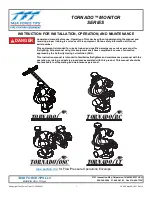
Page 4
Digital Signal Processing
Digital Signal Processing (DSP) is a powerful and complex method of analyzing and
modifying analog signals, such as speech. Speech signals have fairly well known and
predictable characteristics; however, these characteristics are quite complex.
By converting the analog signal to a digital signal, a digital signal processor with a special
program can analyze the characteristics of the analog signal. The digital signal processor
can then modify the digital signal to enhance the desired characteristics and to remove
undesirable characteristics such as noise or tones. The processed signal is converted back
to an analog signal and sent on to a speaker or headphone.
In radio noise, DSP is capable of reducing or eliminating broadband noise and tone
interference.
Overview
This manual describes the DSP-8200d tone suppression and noise reduction system.
The DSP-8200d removes heterodynes (tones) caused during multiple aircraft-to-aircraft
and multiple aircraft-to-controller communications. It also attenuates unwanted signaling
tones that may be inadvertently applied to normal monitoring channels. This tone reduc-
tion wipes out potential hearing-impairing test and interference tones in milliseconds.
The DSP-8200d also provides bandpass filtering from 300 to 3400 Hz (voice telephone
bandwidth).
The DSP-8200d uses advanced digital signal processing technology to implement algo-
rithms that perform three basic audio functions or modes:
• Bandpass filtering from 300 to 3400 Hz
• Tone suppression
• Random noise reduction
There are five configurations of the above modes available in the DSP-8200d. They
include:
• Bandpass filtering and tone suppression
• Bandpass filtering and noise reduction
• Bandpass filtering
• Ground to Ground tone suppression (404, 1004, 2713, 2804, 3200 Hz)
• None
































